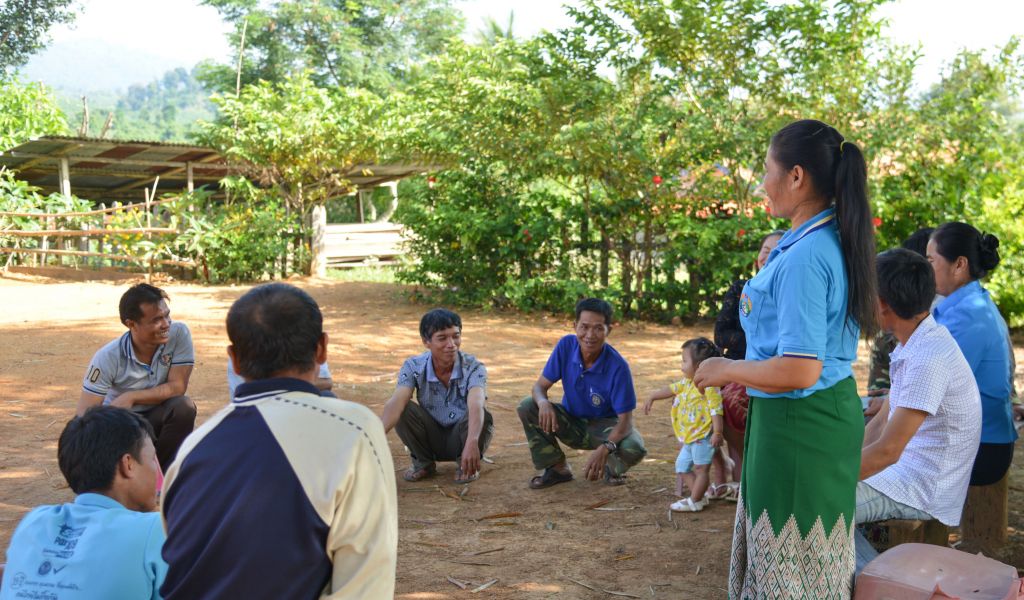Learning how to manage multiple pressures on land in Lao PDR

Opposing interests and competition over land and resources is driving forest conversion in the Lao People’s Democratic Republic. Government and communities more than ever need to collaborate to protect their forests and reduce conflicts.
Representatives from government, civil society and communities will begin working in five villages in Xaiyabouly and Bokeo provinces using what they have learned in a five-day training course on participatory land-use planning, provided by RECOFTC. They will develop village land-use plans and village forest management plans to reduce tensions. These plans protect their forests and other lands by presenting a communally agreed strategy to mitigate effects of population growth, land degradation, competing economic interests and climate change.
This is crucial for Lao PDR where about 80 percent of the people depend on forests for their livelihoods. Communities harvest many products from local forests, including about 700 species of plants, insects and fungi that are used for food, construction and medicine.
A proven approach for success
Participatory land-use planning is an internationally recognized approach to making decisions on the use and management of land, water and other natural resources. It is an interactive process in which local communities work with government representatives to develop land-use plans.
“Participatory land-use planning provides tools for designating how forests and other landscapes should be used, as well as tools for monitoring to follow through on that strategy,” said Bounyadeth Phoungmala, Director of RECOFTC Lao PDR. “The approach relies on the participation of local government, community members and ethnic groups. It allows them to work together to develop land and forestland zoning and management plans that reflect government and local needs and priorities and are owned and implemented by the communities.”
Working with the Land Department of the Ministry of Natural Resources and Environment, RECOFTC organized the five-day training course in Xaiyabouly Province in October 2019.
The 20 participants came from provincial and district departments of natural resources and environment and the provincial department of agriculture and forestry. Through presentations, discussions, groupwork, practice and field work, they learned about the importance of participatory land-use planning for inclusive forest governance. They also trained in community mapping techniques to conduct participatory forest surveys.
“The workshop helped me gain new knowledge, especially about government policies,” said Linthong Koumbasith, a forestry officer from Phiang’s district office of agriculture and forestry in Xaiyabouly province. “I also learned a lot from participants from other districts and provinces. And I gained important skills, such as how to use geographic position and geographic information systems.”
This workshop is part of FLOURISH, an initiative led by RECOFTC and implemented in Lao PDR, Thailand and Viet Nam. The International Climate Initiative (IKI) of the German Federal Ministry for the Environment, Nature Conservation and Nuclear Safety (BMU) is funding this initiative.
Working with local communities
“With participatory land-use planning, villagers have clear ideas on the boundary of their villages, as well as each plot of land and forestland in their village,” said Phoungmala. “It will also help villagers understand which resources are available and how they should be managed.”
The five villages were selected on three criteria. There had to be an opportunity for forest restoration and an availability of non-timber forest products, such as mulberry bark. The villages also had to be located outside one of the country’s three forest categories, which include production forest, conservation forest and protection forest. And the villages could not be the target of any large infrastructure project in the next four years.
“And of course, the villagers had to be willing to join the project,” said Phoungmala.

Putting participatory land-use planning into practice will help the workshop participants be better resource managers and lead to improved government practices and enhanced community social and economic returns, he added.
“It will help prevent and reduce shifting cultivation practices and other harmful uses of land and forestland,” said Phoungmala. “It will also reduce deforestation, forest degradation and conflicts and contribute to climate change mitigation and adaptation.”
###
This story is produced with the financial support of the International Climate Initiative (IKI) of Germany's Federal Ministry for the Environment, Nature Conservation and Nuclear Safety (BMU). Its content is the sole responsibility of RECOFTC and does not necessarily reflect the views of BMU. For more information on FLOURISH visit this page.
RECOFTC’s work is made possible with the support of the Swiss Agency for Development and Cooperation (SDC) and the Swedish International Development Cooperation Agency (Sida).

